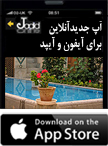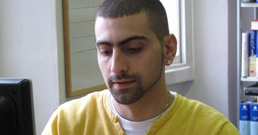
A series of workshops entitled 'Image and Identity' was organized by the Iranian Youth Development Association (IYDA) in London last summer. The young trainees attending the workshops were all of dual culture, in the sense that either one of their parents was Iranian or they were born and brought up in Britain. At the end of this summer course, the trainees attended a multimedia workshop run by JadidOnline to produce multimedia stories, three examples of which can be seen below. Sanaz Movahedi, Natasha Mansouri and Poria Atashzaran have each created images projecting their own concept of their identity. More details about the workshops are given at the bottom of this page.
Sanaz: The other me
Sanaz says that in the past she was confused about her identity as her father is Iranian and her mother British. She remembers that in childhood she used to read bilingual books in English and Persian, but when she grew up she realized that her Persian is not as good as her English. Nevertheless whenever she travelled to Iran she noticed that she became more and more absorbed by the Iranian culture and way of life and felt herself to be more Iranian than British. There was a nagging question constantly occupying her mind: "What are you then, Iranian or British?" Gradually Sanaz came to the conclusion that she is neither Iranian nor British, and at the same time she is both. She can only feel to be a complete person only when she combines both halves of her identity together.
In her multimedia report, she conveys her feelings to us through her works with the title of 'flexible me' or 'plastic me'. She says: "The plastic me, although resembling a shadow, is not a shadow. It is a reflection of myself encompassing both Iranian and British cultures."
Natasha: My lonely father
Natasha was also born of a British mother and Iranian father in Britain. Her mother died of cancer fourteen years ago. This was an enormous emotional blow for both Natasha and her brother, augmented even further by the sorrow and the loneliness that her father felt after losing his wife. Her father, once a lively, humorous and active man, is now depressed and reclusive. Natasha says that every time she visits her father, she finds him occupying himself with housework in order to forget his loneliness.
Her father's loneliness, an image which has played a part in the formation of her identity, is the theme of Natasha's multimedia report. Her father's happiness is one of Natasha's dreams. She says that the only thing that brings a little happiness in his life is visiting Iran and his relatives there.
Poria: Forget me not
Poria has looked for the signs of identity of people around him in some of the objects they have treasured. These objects may not seem to have any value in the eyes of other people, but are priceless for those who have been keeping them. Poria has tried to find out the significance of these objects and the memories they evoke for their owners.
One person considers a string of prayer beads to be his dearest memento from his deceased mother. For another person it is a necklace that her grandmother used to wear, and for someone else it is an old painting left from one of her ancestors that she keeps as her most precious possession. They all say that these objects constitute an integral part of their identity.
Image and Identity
There is an increasing number of young Iranians of dual culture living in Britain. Most of them are trying to have a deeper knowledge and a better understanding of their cultural roots. Iranian Youth Development Association (IYDA) is a London based organisation set up to help young people in their quest.
The manager of IYDA , Sanaz Amidi, says that her organisation deals with both groups of youth- those born of Iranian parents in Britain, and those with either an Iranian father or mother.
In an educational workshop with the theme 'Image and Identity' organised by IYDA and Rosetta Arts Centre in London last summer, 'image' referred to the exterior appearance of a person, and 'identity' to the inner self and the factors that shape one's personality. Similar workshops with the same theme organised by Omid-e Mehr Foundation ran simultaneously in Tehran, the multimedia entitled 'Hidden Faces' can be seen under related articles headline on this page.
The aim of these workshops was to explore the issues relating to the identity of young people of dual culture, to understand their perception of their own identity and that of the others, and to raise their self confidence as well as their knowledge about the diversity of cultures.
During the course the participants also took part in a multimedia production workshop by JadidOnline. They were then asked to produce a report on an aspect of their identity, using photographs and narration. Techniques of photography were taught by the London based Iranian photographer, Omid Salehi. At the end of the course, the works of three trainees, seen above, were selected for publication on JadidOnline.
The work of the IYDA and Omid-e Mehr trainees entitled Imagining Identity is shown at The Silk Road Gallery,




